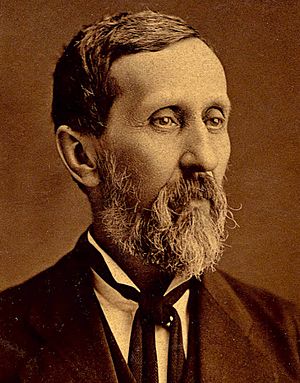Roeliff Brinkerhoff facts for kids
Quick facts for kids
Roeliff Brinkerhoff
|
|
|---|---|

Brevet Brigadier General Roeliff Brinkerhoff
|
|
| Born | June 28, 1828 Owasco, New York |
| Died | June 4, 1911 (aged 82) Mansfield, Ohio |
| Allegiance | United States of America |
| Years of service | 1861-1866 |
| Rank | Colonel Brevet Brigadier General |
| Battles/wars | American Civil War *Capture of Nashville *Siege of Corinth |
| Other work | Lawyer, Newspaper Editor, Bank President, Founder and President of the Ohio Historical Society |
Roeliff Brinkerhoff (born June 28, 1828 – died June 4, 1911) was an important American figure. He was a lawyer, a newspaper editor, and later a bank president. During the American Civil War, he served in the Union Army as a quartermaster. A quartermaster is an officer who handles supplies and transportation for the army. He rose to the rank of colonel.
After the war, he was honored with the rank of brevet brigadier general. His book, "The Volunteer Quartermaster," was a key guide for how the military managed supplies and transportation until World War I. Roeliff Brinkerhoff also started the Ohio Historical Society. He even took over from former President Rutherford B. Hayes as the head of the American National Prison Congress, working to improve prisons.
Early Life and Career
Roeliff Brinkerhoff was born in Owasco, Cayuga County, New York. His parents were Joris R. “George” and Jacomyntje Bevier Brinkerhoff. His family came from French Huguenots, a group of French Protestants.
When he was just sixteen, Roeliff started working as a teacher in his hometown. By eighteen, he was in charge of a school near Hendersonville, Tennessee. The next year, he worked as a tutor for the family of Andrew Jackson Jr..
He then moved to Mansfield, Ohio, to study law with his relative, Jacob Brinkerhoff. In 1852, he became a lawyer. He worked as a lawyer until the Civil War began. He also edited the Mansfield Herald newspaper.
On February 3, 1852, Roeliff married Mary Lake Bentley in Mansfield. They had two sons and two daughters. Roeliff believed strongly in making prisons and mental hospitals better. He changed his political party several times, showing he was always looking for the best way to help people. He was known for believing in "home rule" and less government interference.
Service in the Civil War
Roeliff Brinkerhoff joined the army in September 1861. He started as a first lieutenant and the quartermaster for the 64th Ohio Infantry regiment. Some people say he was the first officer to join the "Sherman Brigade" under Brigadier General William Tecumseh Sherman.
In December 1861, he was sent to manage a supply depot in Bardstown, Kentucky. After the Union army captured Nashville, he was put in charge of all land and river transportation there. After the Battle of Shiloh, he was ordered to the front lines. He then managed the transportation of supplies for the Army of the Ohio.
After the capture of Corinth, he went home on sick leave. Once he was better, he was sent to Maine as the Chief Quartermaster for the state. There, he became good friends with Congressman James G. Blaine. He was later moved to Pittsburgh, where he managed transportation and army supplies.
Next, he went to Washington D.C. to be the post quartermaster until June 1865. At that time, he was made a Colonel and an inspector for the quartermaster's department. He stayed working with Secretary of War Edwin Stanton until November. Then, he was sent to Cincinnati as the Chief Quartermaster for the Department of the Ohio.
Brinkerhoff asked to leave the volunteer service on September 30, 1866. To recognize his great service, President Andrew Johnson nominated him for the rank of brevet brigadier general. The U.S. Senate approved this on February 6, 1867. He wrote "The Volunteer Quartermaster," which was a very important guide for army supply officers until World War I.
After the War: A Life of Service
After the Civil War, Roeliff Brinkerhoff became close friends with many famous people. These included Salmon P. Chase, James G. Blaine, James A. Garfield, and Rutherford B. Hayes. In 1873, he became the President of the Mansfield Savings Bank.
In 1878, he was appointed to the board of state charities. He stayed in this role for thirty years, serving under many different leaders. This shows his long-term dedication to helping others.
Brinkerhoff was a strong advocate for improving mental hospitals. He used his political connections to stop the use of harsh physical restraints on patients. At first, people called his ideas "Brinkerhoff's Folly." However, his work led to the Toledo hospital system becoming a model for mental hospitals across the United States. He was chosen to be part of the group that planned its construction. He was one of the first Americans to support the "cottage system." This system involved smaller, more home-like buildings for patients, showing he understood that people wanted better care.
In 1875, Brinkerhoff founded the Ohio State Archaeological and Historical Society at his home. This organization's first president was Senator Allen G. Thurman, followed by Rutherford B. Hayes. After Hayes' death, Brinkerhoff himself became president. He was later named President Emeritus, and the organization still exists today.
Through this society, he helped get laws passed and money for the Ohio Monument in Jefferson Park, Chicago. He gave a powerful speech to the legislature, saying that Ohio was special because of its famous people. He suggested that Ohio should be represented at a fair by a statue of a noble woman (Ohio) surrounded by her "jewels"—great leaders like Grant, Sherman, and Garfield. This idea was approved, and money was set aside for the monument.
When the Ohio monument was dedicated in Chicago on September 14, 1893, General Brinkerhoff gave one of the main speeches.

